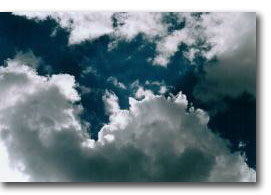Water Clouds
xantox, 17 September 2007 in GalleryOther Languages:
Terrestrial clouds are the result of extraordinarily complex interactions between water and air, with several feedback mechanisms combining the effects of fluid dynamics and thermodynamics.1

Click image to zoom2
The kind of convective clouds known as cumulus are produced by the vertical winds occurring in regions of warm moist air, according to Archimedes principle. The rapid lifting results in adiabatic expansion and cooling, and consequent accretion of water droplets. The irregular distribution of droplets scatters sunlight geometrically in all directions, producing a bright white appearance like in snow, decaying into gray shades as per their optical thickness. Each cloud is short-lived, lasting approximately 15 minutes in average.
- H. R. Pruppacher, J. D. Klett, “Microphysics of clouds and precipitation“, Springer (1997); R. A. Houze, “Cloud Dynamics“, Academic Press (1994) [↩]
- © 2004 Sarah Robinson, Flow Visualization Course, University of Colorado [↩]

